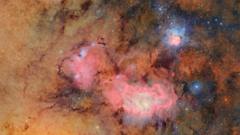In April, the astronomical community buzzed with excitement when researchers suggested the potential discovery of signs of life on the exoplanet K2-18b, located over 120 light-years away from Earth. However, a thorough re-evaluation of the data by multiple independent research teams has emerged, sharply refuting this claim.
The initial study indicated that K2-18b’s atmosphere contained a particular molecule that could be linked to biological processes. Yet, in a recent batch of reviews, astronomers have collectively concluded that the supposed signals of life are unsubstantiated. “The claim just absolutely vanishes,” remarked Luis Welbanks from Arizona State University, one of the scientists involved in the investigation.
The confusion lies less in the search for extraterrestrial life and more in the complexities surrounding the observation of distant planets. Unlike closer bodies like Jupiter, which can visibly reflect sunlight, K2-18b’s far-off status renders it virtually undetectable via traditional telescopes.
To explore such distant astronomical bodies, scientists have developed innovative methodologies. Monitoring stellar wobbles and gravitational pulls has yielded insights into planetary systems. For instance, in 2010, researchers glimpsed exoplanet GJ 1214b when it transited its host star, revealing water vapor in its atmosphere as starlight filtered through.
The James Webb Space Telescope, launched in 2022, has since provided a significant leap forward in this aspect of astronomy. Its advanced capabilities have allowed astronomers to dissect and discern faint patterns in starlight, yielding essential information regarding the atmospheres of far-flung worlds.
Despite the exciting initial reports about K2-18b, the findings underline the delicate nature of astronomical research and the ongoing quest to understand the universe's vast unknowns. The scientific community remains steadfast in its commitment to further exploration and verification.























